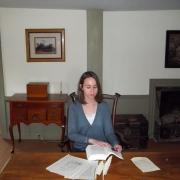History
Unmask Alice : LSD, satanic panic, and the imposter behind the world's most notorious diaries
Rick Emerson
813.54 /Sparks
History
In 1971, the anonymously published Go ask Alice-- the supposed diary of a middle-class addict-- reinvented the young adult genre with a blistering portray of sex, psychosis, and teenage self-destruction. In 1979 Jay's journal- the posthumous memoir of an alleged teenage Satanist-- poisoned whole communities. In reality the two books were written by Beatrice Sparks, a serial con artist who betrayed a grieving family stole a dead boy's memory, and lied her way to the National Book Awards. Emerson explores this true story of contagious deception. -- adapted from jacket.
The secret history of home economics : how trailblazing women harnessed the power of home and changed the way we live
Danielle Dreilinger
640.922 /Dreilinger
History
"The surprising, often fiercely feminist, always fascinating, yet barely known, history of home economics. The term "home economics" may conjure traumatic memories of lopsided hand-sewn pillows or sunken cakes. But obscured by common conception is the story of the revolutionary science of better living. The field exploded opportunities for women in the twentieth century by reducing domestic work and providing jobs as professors, engineers, chemists, and businesspeople that were otherwise foreclosed. In The Secret History of Home Economics, Danielle Dreilinger traces the field's history from small farms to the White House, from Victorian suffragists to Palo Alto techies. Home economics followed the currents of American culture even as it shaped them; Dreilinger brings forward the racism within the movement along with the strides taken by Black women who were influential leaders and innovators. She also looks at the personal lives of home economics' women, as they chose being single, shared lives with women, or tried for egalitarian marriages. This groundbreaking and engaging history restores a maligned subject to its rightful importance"--
I had to pause reading this book a lot to tell anyone who happened to be nearby the interesting piece of trivia I just learned. There is a rich history of home economics, and the remarkable women involved with every aspect of its development, and every page gives you something new and fascinating. Great read! -Amanda
Fatherland : a memoir of war, conscience, and family secrets
Burkhard Bilger
940.5343 /Bilger
History, Memoir
"What do we owe the past? How to make peace with a dark family history? Burkhard Bilger hardly knew his grandfather growing up. His parents immigrated to Oklahoma from Germany after World War II, and though his mother was an historian, she rarely talked about her father or what he did during the war. Then one day a packet of letters arrived from Germany, yellowing with age, and a secret history began to unfold. Karl Gönner was a schoolteacher and Nazi party member from the Black Forest. In 1940, he was sent to a village in occupied France and tasked with turning its children into proper Germans. A fervent Nazi when the war began, he grew close to the villagers over the next four years, till he came to think of himself as their protector, shielding them from his own party's brutality. Yet he was arrested in 1946 and accused of war crimes. Was he guilty or innocent? A vicious collaborator or just an ordinary man, struggling to atone for his country's crimes? Bilger goes to Germany to find out"--
As Bilger asserts in his family memoir, Fatherland, everyone will find something haunting in their own family tree. His own is his grandfather. Karl Gönner, a member of the Nazi party and schoolteacher was sent to Alsace in occupied France to "reeducate" the children of Bartenheim. He was promoted to head of the Nazi party in the town overseeing required work assignments. Grappling with this information, Bilger returns to the region, researching and seeking what his grandfather did, trying to find why he would participate. With all of these things, it's complicated. Bilger writes thoughtfully and openly, taking on a painful, hurtful subject. -Anne M
The Wager : a tale of shipwreck, mutiny and murder
David Grann
910.9164 /Grann
Literary Nonfiction, Nonfiction, History
"From the #1 New York Times bestselling author of Killers of the Flower Moon and The Lost City of Z, a mesmerizing story of shipwreck, survival, and savagery, culminating in a court martial that reveals a shocking truth On January 28, 1742, a ramshackle vessel of patched-together wood and cloth washed up on the coast of Brazil. Inside were thirty emaciated men, barely alive, and they had an extraordinary tale to tell. They were survivors of His Majesty's Ship the Wager, a British vessel that had left England in 1740 on a secret mission during an imperial war with Spain. While the Wager had been chasing a Spanish treasure-filled galleon known as "the prize of all the oceans," it had wrecked on a desolate island off the coast of Patagonia. The men, after being marooned for months and facing starvation, built the flimsy craft and sailed for more than a hundred days, traversing 2500 miles of storm-wracked seas. They were greeted as heroes. But then ... six months later, another, even more decrepit craft landed on the coast of Chile. This boat contained just three castaways, and they had a very different story to tell. The thirty sailors who landed in Brazil were not heroes - they were mutineers. The first group responded with countercharges of their own, of a tyrannical and murderous captain and his henchmen. It became clear that while stranded on the island the crew had fallen into anarchy, with warring factions fighting for dominion over the barren wilderness. As accusations of treachery and murder flew, the Admiralty convened a court martial to determine who was telling the truth. The stakes were life-and-death-for whomever the court found guilty could hang. The Wager is a grand tale of human behavior at the extremes told by one of our greatest nonfiction writers. Grann's recreation of the hidden world on a British warship rivals the work of Patrick O'Brian, his portrayal of the castaways' desperate straits stands up to the classics of survival writing such as The Endurance, and his account of the court martial has the savvy of a Scott Turow thriller. As always with Grann's work, the incredible twists of the narrative hold the reader spellbound. Most powerfully, he unearths the deeper meaning of the events, showing that it was not only the Wager's captain and crew who were on trial - it was the very idea of empire"--
I actually bought my own copy of this book because I just couldn't wait...it was worth the splurge! It's no secret that I'm already a fan of David Grann's writing, so it should come as no surprise that I'm loving this book. It's not even like seafaring and wrecks are my thing, but the way he writes about it, they might as well be. The story comes alive, through the details of the souls on board the ships and everything they went through, their dreams, emotions, fears, and actions. The ships and the environments even become characters of a sort in the story, as they have their own powers over the fates of everyone on board and waiting at home. Thrilling history here! -Candice
Fit nation : the gains and pains of America's exercise obsession
Natalia Mehlman Petrzela
306.4613 /Petrzela
History, Health
"Natalia Mehlman Petrzela, a leading scholar and proselytizer for physical well-being, elucidates the political and social implications of America's exercise cult(ure). Delving into the paradox of why so many Americans are physically unfit, despite the power of the exercise industry, Petrzela shows fitness to be both a product and a marker of education, social class, wealth, power, and more. Like much in postwar American life, fitness has been privatized, and the resulting dominant ideology of exercise is a product of neoliberal political and culture choices. Petrzela reveals a story that puts Charles Atlas, Jane Fonda, the Chippendales, and so many lesser-known people at the center of American culture, media, and politics."--
This was a really fun read - giving a swift and entertaining rundown of the history of American fitness and how the culture around fitness, and how we react to it, has evolved over the decades. -Amanda
There will be fire : Margaret Thatcher, the IRA, and two minutes that changed history
Rory Carroll
941.60824 /Carroll
History
"A bomb planted by the Irish Republican Army exploded at 2:54 a.m. on October 12, 1984. It was the last day of the Conservative Party Conference at the Grand Hotel in the coastal town of Brighton, England. Rooms were obliterated, dozens of people wounded, five killed. Prime Minister Margaret Thatcher was in her suite when the explosion occurred; had she been just a few feet in another direction, flying tiles and masonry would have sliced her to ribbons. As it was, she survived--and history changed. There Will Be Fire is the gripping story of how the IRA came astonishingly close to killing Thatcher, in the most spectacular attack ever linked to the Northern Ireland Troubles. Journalist Rory Carroll reveals the long road to Brighton, the hide-and-seek between the IRA and British security services, the planting of the bomb itself, and the painstaking search for clues and suspects afterward"--Dust jacket flap.
With very compelling storytelling, journalist Rory Carroll takes on the IRA's assassination attempt of Prime Minister Margaret Thatcher at a hotel in Brighton during the Conservative Party Conference. Part-history, part-true crime, this is really a great read. Carroll provides context to the Troubles and the Irish and British political situation at the time, as well as the stories of the people involved in the attempt and the manhunt as well as the lives disrupted by the violence. -Anne M
A fever in the heartland : the Ku Klux Klan's plot to take over America, and the woman who stopped them
Timothy Egan
322.42 /Egan
History
"A historical thriller by the Pulitzer and National Book Award-winning author that tells the riveting story of the Klan's rise to power in the 1920s, the cunning con man who drove that rise, and the woman who stopped them. The Roaring Twenties -- the Jazz Age -- has been characterized as a time of Gatsby frivolity. But it was also the height of the uniquely American hate group, the Ku Klux Klan. Their domain was not the old Confederacy, but the Heartland and the West. They hated Blacks, Jews, Catholics and immigrants in equal measure, and took radical steps to keep these people from the American promise. And the man who set in motion their takeover of great swaths of America was a charismatic charlatan named D.C. Stephenson. Stephenson was a magnetic presence whose life story changed with every telling. Within two years of his arrival in Indiana, he'd become the Grand Dragon of the state and and the architect of the strategy that brought the group out of the shadows - their message endorsed from the pulpits of local churches, spread at family picnics and town celebrations. Judges, prosecutors, ministers, governors and senators across the country all proudly proclaimed their membership. But at the peak of his influence, it was a seemingly powerless woman - Madge Oberholtzer - who would reveal his secret cruelties, and whose deathbed testimony finally brought the Klan to their knees"--
This is a gripping history of the Klan's resurgence in the United States during the 1920's--especially it's control over Indiana state and local government. Of course, I wouldn't expected anything less than an important topic that is well-researched and well-written from Timothy Egan. Yes, it is great storytelling, but it is also an important history that we cannot look away from. -Anne M
Lodge : an indoorsy tour of America's national parks
Max Humphrey
917.352 /Humphrey
Travel, Nature, History
Max Humphrey shines a light on 10 rustic National Park lodges in all their airy, timeworn splendor. No historic photos here; the images of the architecture and interiors are as they look today, highlighting these storied places in a fresh, alluring way. Sure, the lobbies are the main stage, but Humphrey touches on grand dining rooms, guest rooms, and rustic canteens alike. He writes about the buildings themselves in terms of the historical goings-on at the time, why they were built, and the players involved, highlighting notable architectural moments and period-specific furnishings. A smattering of pop culture history adds extra bursts of levity throughout.
I have caught the travel-planning bug and am fantasizing about all the places to go. Surely I'm not the only one who dreams of staying in cozy lodging in one of our nation's majestic national parks? If you're like me in that sense, do take a look at this book. "Lodge" had me at plaid, the buffalo pattern unmistakingly a siren call to join the great outdoors. Really that's all I want in a vacation: the woods, the sweat, and the constant tiny insect bites reminding me I'm alive. (Just kidding. I slather myself in DEET the second I see my first mosquito. Just say No to itchy skin, kids!) -Melody
The great air race : glory, tragedy, and the dawn of American aviation
John (Journalist) Lancaster
629.1309 /Lancaster
History, Technology
Lancaster recounts the incredible, untold story of the transcontinental air race of October 1919. The contest awakened Americans to the practical possibilities of flight-- and riveted the nation. Most of the pilots were veterans of World War I, flying DH-4s and Fokkers that were almost comically ill-suited for long distance travel. The aviators braved blizzards and mechanical failure, landing in cornfields or at the edges of cliffs. The race was a test of endurance that many pilots didn't finish because of exhaustion, mechanical failure-- or their deaths. -- adapted from jacket
A lot of was riding on this first of its kind coast-to-coast airplane race. Billy Mitchell was hoping to have Congress create an independent air force. The post office wanted to establish an airmail service. Multiple entrepreneurs wanted the public to buy into the idea of air travel. The great transcontinental air race of October 1919 was going to prove these things were needed and practical. Lancaster provides a detailed portrait on the state of aeronautics after World War I, the characters and personalities involved in the race, and the repercussions of a successful, yet deadly contest. Air historians or people who love micro-histories will enjoy this book. -Anne M
The Monkey Trial : John Scopes and the battle over teaching evolution
Anita Sanchez
CATALOGING /
Kids, Science, History
"Arrested? For teaching? John Scopes's crime riveted the world, and crowds flocked to the trial of the man who dared to tell students about a forbidden topic--evolution. The year was 1925, and discussing Darwin's theory of evolution was illegal in Tennessee classrooms. Lawyers wanted to challenge the law, and businessmen smelled opportunity. But no one imagined the firestorm the Scopes Trial would ignite--or the media circus that would follow. As reporters, souvenir-hawking vendors, angry protestors, and even real monkeys mobbed the courthouse, a breathless public followed the action live on national radio broadcasts. All were fascinated by the bitter duel between science and religion, an argument that boiled down to the question of who controls what students can learn--an issue that resonates to this day."--Page [2] of cover.
Who controls what students can learn - parents or the government? What takes precendence, science or religion? What happens when scientific evidence is turned into a political battle? Find out in this book for young readers about - you guessed it! - the 1925 trial of science teacher John Scopes, who defied the law by teaching about Darwin's theory of evolution in the classroom. Whether the cyclical nature of these struggles provides a comfort or makes you feel hopeless, there's no doubt that history repeats itself. Find out what lessons the "Monkey Trial" holds for us today in this new book aimed at 8-12-year-olds. -Anne W






If you've ever wondered about the true story behind Go Ask Alice... this is the book for you. You'll learn all about the author behind the famous book and similar titles, and get a better grasp of the people she based them on. I really appreciated the thorough biography of the real Jay of Jay's Journal, and that was actually the highlight for me. If you read any of those "anonymous" books as a teen, you'll want to read this as well. -Amanda